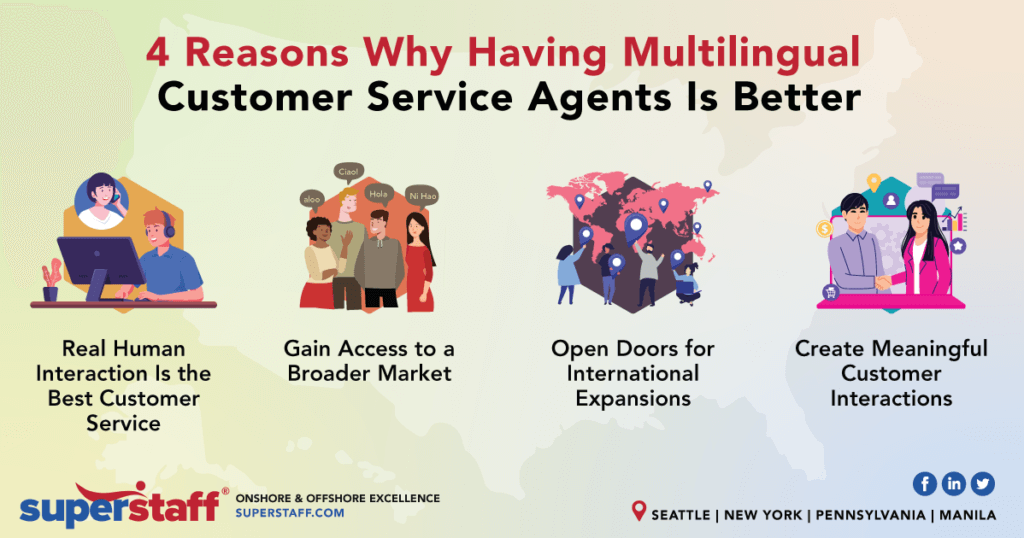
The customer experience journey doesn’t end after a purchase. You need to find better ways to keep your customers satisfied post-sales or risk losing their loyalty. And when it comes to first-rate customer service, your company needs to go above and beyond expectations. In that regard, offering customer support in only one language is never enough.
Fact: Not all of your customers speak English. The most recent data showed that 67.3 million residents use a language other than English at home in the U.S. alone. Even if your customers are among those who can speak English, it doesn’t necessarily mean they prefer using it.
So, how can you reach out to them more effectively when they don’t prefer speaking English? The key is having a team of multilingual customer service agents.
Interesting Statistics About Multilingual Customer Service Support
Are you thinking about expanding your business or maybe just raising the bar for your customer service? A survey conducted on more than 8,700 consumers across 29 countries shows us why going multilingual would put you above your competition in this digitally connected world.
- About 75% of respondents said they are more likely to repurchase the same brand if customer service was available in their native language.
- When choosing between two similar products, 76% of respondents preferred to buy a product with information in their native language when given a choice.
These compelling figures prove the importance of language in customer service. However, its significance took a back seat when automated multilingual customer service channels overwhelmed the market.
Automated Multilingual Customer Service Channels
Automated multilingual customer service channels make it easier for customers to solve problems in a language they feel most comfortable with. Here are some of the popular automated multilingual customer self-service options:
#1: Online Knowledge Bases
Nowadays, it’s common for businesses to have help sections or other knowledge portals on their website or app. These portals have translatable content for customers who speak different languages.
Often, knowledge bases come in the form of walk-throughs, How-Tos, and frequently asked questions (FAQs). These are designed to help customers navigate issues on their own and lessen the likelihood of consumers calling customer service for repetitive concerns.
#2: Interactive Voice Response (IVR)
Interactive voice response systems date back to the mid-1970s, making them one of the oldest forms of customer self-service. Nowadays, IVR systems have evolved to become gatekeepers in phone customer service. The most recent advancement is the multilingual IVR system.
The multilingual IVR system asks callers the language they prefer. The system then instructs customers to press certain numbers, which would route the calls to specific departments best equipped to address their concerns. At times, IVR systems also play pre-recorded messages to give the customer the information they need, so they no longer have to wait for a live agent to pick up the call.
#3: Mobile Help Apps
In this digital age, our smartphones are practically extensions of ourselves. Hence, brands integrate self-service mechanisms on their mobile apps, reworking them into one-stop shops that offer everything from product information to customer service.
Multilingual Chatbots
A multilingual chatbot is another form of automated self-service channel. This application uses an AI virtual assistant that allows you to communicate with your customers in their language. Adapting multilingual chatbots is a great way to localize international brands.
How Multilingual Chatbots work
Through machine learning, bots can simulate a natural human conversation. They often rely on a program called the National Language Understanding to interpret non-English queries and offer pre-set responses that come in different languages.
However, there’s one significant downside to using multilingual chatbots. You’ve probably seen memes poking fun at Google Translate’s (too) literal translation of some phrases and words. That’s because language is nuanced, and a lot can get lost in translation. The same goes for multilingual chatbots.
Are Automated Multilingual Customer Service Channels Enough?
Although most self-service channels can solve a wide range of your customers’ complaints, these tools can only do so much. What happens after the customer has gone through all the channels, but their issue remains unresolved?
Even the most comprehensive multilingual customer service channel is bound to have blind spots. No matter how expertly programmed a chatbot is, it is still not human. Your customers will desire to speak to a person who responds according to how their communication evolves. This is why you still need a team of reliable multilingual customer service agents.

Advantages of Having Multilingual Customer Service Agents
#1: Real Human Interaction Is the Best Customer Service
Speed is good, but automation doesn’t always mean good customer service. In the same sense, a quick response doesn’t guarantee a resolution to the problem.
Studies show that consumers overwhelmingly prefer human interaction over bots when it comes to customer service. This is because support agents have something that bots don’t have: The ability to understand a customer’s concern and empathize with them.
One survey found that nearly 7 in 10 respondents (69%) said speaking with live agents is one of their most preferred customer service communication methods. Asked to rank the most important qualities of a support agent, consumers ranked willingness to help, pleasantness, and compassion highly.
Here are other crucial findings of the survey:
- 60% chose “willingness to help”
- 60% selected problem-solving ability
- 58% picked product/service knowledge
- 54% valued either pleasantness or compassion
#2: Gain Access to a Broader Market
According to research, 68% of customers are willing to switch brands to get customer service in their native tongue. This means that going multilingual gives your company access to a broader market.
Even if you have no plans for physical expansions overseas, you still need multi-lingual customer service. As mentioned, there are 67.3 million residents who speak a language other than English at home in the U.S.
Top 3 Foreign Languages Spoken in the United States
#1: Spanish
There are roughly 43 million Spanish speakers in the U.S., making it the second-largest Spanish-speaking population after Mexico, eclipsing even Spain itself. Observers even predict that the U.S. will have the largest Spanish-speaking population by 2050.
#2: Chinese (Mandarin and Cantonese)
Ever since the California Gold Rush in the mid-19th century forced many to cross the Pacific Ocean, the U.S. has seen a steady influx of Chinese immigrants. Over the years, the number of Chinese-Americans in the U.S. has grown to over 5 million. Today, there are around 3.5 million speakers of both Cantonese and Mandarin in the country.
#3: Tagalog
Human capital is considered one of the Philippines’ biggest exports, so migrating to find employment is common among Filipinos. Many have been migrating to the U.S. as early as the 19th century. To date, there are more than 1.7 million Tagalog speakers in the U.S.
#3: Open Doors for International Expansions
If you plan to go global, providing multilingual customer care is necessary. Across the globe, only 1.3 billion speak English out of roughly 7.8 billion people. You will miss a market of over 6 billion non-English speaking people if you don’t go multilingual.
Most Spoken Languages in the World
-
German
Germany is a significant economic force in Europe and the world. With a population of nearly 84 million people and a GDP of $3.9 trillion, the country has established a solid footing in the e-commerce, global manufacturing, science, and technology trade sectors.
-
Italian
Italian is the second most widely spoken language in the European Union, with 67 million native speakers. It is also the official language of Switzerland, Vatican City, and other surrounding territories.
-
Japanese
The Japanese’s penchant for local brands, which is deeply rooted in their culture, makes it difficult to break into their market. Those who want to tap into this market must speak the language. Businesses should also rise to the challenge of meeting Japanese customer service and hospitality standards, which is revered worldwide as an art form.
-
Korean
When it comes to online shopping, South Koreans have overtaken the rest of the Asia-Pacific region. As their influence in pop culture continues to grow worldwide, now is the perfect time to tap into the South Korean market. However, you must offer customer support in the Korean language to achieve this. Koreans expect their partners to speak their language as a sign of mutual respect.
-
Russian
The Russian economy has enormous potential. If you want to establish a long-term presence in Russia, focus on establishing relationships with Russian customers. Considering that Russians are more at ease when they feel that they can trust the person they are speaking with, it is first imperative that your customer support solutions are available in their native language.
#4: Create Meaningful Customer Interactions
Picture this scenario: There is an elderly Filipino customer who is already having a bad day because she can’t get her new microwave to work. She felt even more frustrated because most agents couldn’t understand her accent.
After several attempts, she was ecstatic when the next agent who picked up the phone asked, “Kabayan? (Fellow Filipino?).” “Mismo, hija! (Exactly, dear!),” she said after letting out a huge sigh of relief. The grandma felt like she was talking to her granddaughter, giving her step-by-step instructions.
Many moments alike transpire between customer service agents and callers who speak other languages. Exchanges with chatbots or mobile apps will never replace those meaningful interactions that can set your brand apart from your competition.
Read more: Ultimate Guide to Multilingual Customer Support | SuperStaff
Build Your Multilingual Customer Service Team With Superstaff
Don’t let language get in the way of outstanding customer service.
Break barriers and watch your business grow exponentially as you empower all your customers, no matter what language they speak. With our brand of customer service excellence, Superstaff can provide you with 24/7 support capability. We offer a diverse range of multilingual customer service solutions in the most widely spoken languages across all channels.
Team up with Superstaff to boost your customer service game and expand your global reach. Contact us today to find out how we can help.






